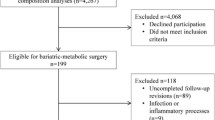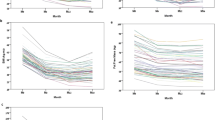Abstract
Background
Obesity and its consequences have now reached worldwide pandemic proportions. Among treatments, bariatric interventions are the most effective for weight reduction. Here, we describe the change in anthropometric measurements (AMs) of 615 adult bariatric procedure patients seen in the private practice of a registered dietitian (RD) in Bogotá, Colombia.
Methods
Observational retrospective study of AMs recorded between 1996 and 2013 for patients who had laparoscopic sleeve gastrectomy (LSG, n = 290), laparoscopic adjustable gastric banding (LAGB, n = 207), and laparoscopic Roux-EN-Y gastric bypass (LRYGB, n = 36) or the non-surgical gastric balloon (GB, n = 82) procedure. Patients had three bimonthly follow-up visits. Paired t tests compared baseline (first) and 6-month (fourth) follow-up visit values.
Results
Differences in AMs between the baseline and fourth visits were statistically significant for the surgical interventions. A mean weight loss of 22 kg, equivalent to a 22% total body weight loss, together with significant reduction of the waist-to-height-ratio (WHtR)(p < 0.001) and body mass index (BMI)(p < 0.001), was observed across all procedures.
Conclusions
The use of multiple AMs enables a comprehensive assessment of body composition in patients who undergo bariatric procedures. Our study is a useful resource for international future reference and highlights the impact that the RD can have on understanding and influencing the effectiveness of bariatric procedures.

Similar content being viewed by others
References
World Health Organization (2015) Nocommunicable diseases fact sheet. http://www.who.int/mediacentre/factsheets/fs355/en/. Updated January
World Health Organization (2016) Obesity and overweight. http://www.who.int/mediacentre/factsheets/fs311/en/. Updated January
Instituto Colombiano de Bienestar Familiar. Encuesta Nacional de la Stiuación Nutricional en Colombia 2010 - ENSIN. Bogotá: Da Vini Editores; 2011.
Bjorntorp P. Treatment of obesity. Int J Obes Relat Metab Disord. 1992;16(Suppl 3):S81–4. PubMed PMID: 1338327
Dixon JB, Strauss BJ, Laurie C, et al. Changes in body composition with weight loss: obese subjects randomized to surgical and medical programs. Obesity (Silver Spring). 2007;15(5):1187–98. PubMed PMID: 17495195
Heymsfield SB, Harp JB, Reitman ML, et al. Why do obese patients not lose more weight when treated with low-calorie diets? A mechanistic perspective. Am J Clin Nutr. 2007;85(2):346–54. PubMed PMID: 17284728
Caballero B. A nutrition paradox--underweight and obesity in developing countries. N Engl J Med. 2005;352(15):1514–6. PubMed PMID: 15829531
Courcoulas AP, Yanovski SZ, Bonds D, et al. Long-term outcomes of bariatric surgery: a National Institutes of Health symposium. JAMA Surg. 2014;149(12):1323–9. PubMed PMID: 25271405
Cheng J, Gao J, Shuai X, et al. The comprehensive summary of surgical versus non-surgical treatment for obesity: a systematic review and meta-analysis of randomized controlled trials. Oncotarget. 2016;24 PubMed PMID: 27233078
Baker MT. The history and evolution of bariatric surgical procedures. Surg Clin North Am. 2011;91(6):1181–201. viii. PubMed PMID: 22054148
Buchwald H, Oien DM. Metabolic/bariatric surgery worldwide 2011. Obes Surg. 2013;23(4):427–36. PubMed PMID: 23338049
Diamantis T, Apostolou KG, Alexandrou A, et al. Review of long-term weight loss results after laparoscopic sleeve gastrectomy. Surg Obes Relat Dis. 2014;10(1):177–83. PubMed PMID: 24507083
Colquitt JL, Pickett K, Loveman E, et al. Surgery for weight loss in adults. Cochrane Database Syst Rev. 2014;8 CD003641. PubMed PMID: 25105982
Arabi Basharic F, Olyaee Manesh A, Ranjbar Ezzat Abadi M, et al. Evaluation of laparoscopic sleeve gastrectomy compared with laparoscopic Roux-en-Y gastric bypass for people with morbid obesity: a systematic review and meta-analysis. Med J Islam Repub Iran. 2016;3:354. PubMed PMID: 27453881
Schneider J, Peterli R, Gass M, et al. Laparoscopic sleeve gastrectomy and roux-en-Y gastric bypass lead to equal changes in body composition and energy metabolism 17 months postoperatively: a prospective randomized trial. Surg Obes Relat Dis. 2016;12(3):563–70. PubMed PMID: 26656669
Patiño J. Cirugía Bariátrica. Rev Colomb Cir. 2003;18:28–50.
Waist circumference and waist–hip ratio: report of a WHO expert consultation. http://apps.who.int/iris/bitstream/10665/44583/1/9789241501491_eng.pdf?ua=1. 2008;cited May 2015
Moroshko I, Brennan L, O’Brien P. Predictors of dropout in weight loss interventions: a systematic review of the literature. Obes Rev. 2011;12(11):912–34. PubMed PMID: 21815990
Campos GM. Is body mass index an adequate measure for individualized clinical decision making? Surg Obes Relat Dis. 2013;9(3):428. PubMed PMID: 23434276
Landi F, Liperoti R, Onder G. The usefulness of anthropometric measures. Eur J Nutr. 2013;52(6):1683. PubMed PMID: 23818050
Ramirez-Velez R, Correa-Bautista JE, Martinez-Torres J, et al. LMS tables for waist circumference and waist-height ratiso in Colombian adults: analysis of nationwide data 2010. Eur J Clin Nutr. (2016);70(10):1189–96.
Keys A, Brozek J, Henschel A, et al. The biology of starvation, vol. Volume I. Minneapolis: The University of Minnesota Press; 1950. p. 137.
Tucker M (2015) Neck circumference may help predict cardiometabolic risk. http://www.medscape.com/viewarticle/845250 - vp_1.cited June
Bouchard C. BMI, fat mass, abdominal adiposity and visceral fat: where is the ’beef’? Int J Obes. 2007;31(10):1552–3. PubMed PMID: 17549092
Pouliot MC, Despres JP, Lemieux S, et al. Waist circumference and abdominal sagittal diameter: best simple anthropometric indexes of abdominal visceral adipose tissue accumulation and related cardiovascular risk in men and women. Am J Cardiol. 1994;73(7):460–8. PubMed PMID: 8141087
Despres JP. Body fat distribution and risk of cardiovascular disease: an update. Circulation. 2012;126(10):1301–13. PubMed PMID: 22949540
Bennasar-Veny M, Lopez-Gonzalez AA, Tauler P, et al. Body adiposity index and cardiovascular health risk factors in Caucasians: a comparison with the body mass index and others. PLoS One. 2013;8(5):e63999.PubMed PMID: 23734182. Pubmed Central PMCID: PMC3667028
Ashwell M, Gunn P, Gibson S. Waist-to-height ratio is a better screening tool than waist circumference and BMI for adult cardiometabolic risk factors: systematic review and meta-analysis. Obes Rev. 2012;13(3):275–86. PubMed PMID: 22106927
Strain GW, Gagner M, Pomp A, et al. Comparison of weight loss and body composition changes with four surgical procedures. Surg Obes Relat Dis. 2009;5(5):582–7. PubMed PMID: 19560983
Varela JE. Laparoscopic sleeve gastrectomy versus laparoscopic adjustable gastric banding for the treatment severe obesity in high risk patients. JSLS. 2011;15(4):486–91. PubMed PMID: 22643503. Pubmed Central PMCID: PMC3340957
Livhits M, Mercado C, Yermilov I, et al. Does weight loss immediately before bariatric surgery improve outcomes: a systematic review. Surg Obes Relat Dis. 2009;5(6):713–21. PubMed PMID: 19879814
Ponce J. Laparoscopic adjustable gastric banding: technique and outcomes. In: Nguyen N, Blackstone R, Morton J, Ponce J, editors. The ASMBS textbook of bariatric surgery volume 1 bariatric surgery. New York: Springer; 2015. p. 202.
Acknowledgements
The authors wish to acknowledge Jenny Machetá, Diego Prieto, and Giovanni Pulido, librarians from Academia Nacional de Medicina and Universidad de los Andes, Bogotá, Colombia. Jennifer Lewis Uribe and Santiago Uribe-Lewis for editorial assistance.
Author information
Authors and Affiliations
Corresponding author
Ethics declarations
Funding
None to declare.
Ethical Approval
For this type (retrospective) of study, formal consent is not required. All procedures were in accordance with the ethical standards of the institutional and/or national research committee and with the 1964 Helsinki Declaration and its later amendments or comparable ethical standards.
Conflict of Interest
The authors declare that they have no conflict of interest.
Rights and permissions
About this article
Cite this article
Carvajal, C., Savino, P., Ramirez, A. et al. Anthropometric Assessment for Bariatric Procedures in the Private Practice of a Registered Dietitian in Colombia. OBES SURG 27, 1612–1621 (2017). https://doi.org/10.1007/s11695-016-2521-5
Published:
Issue Date:
DOI: https://doi.org/10.1007/s11695-016-2521-5




